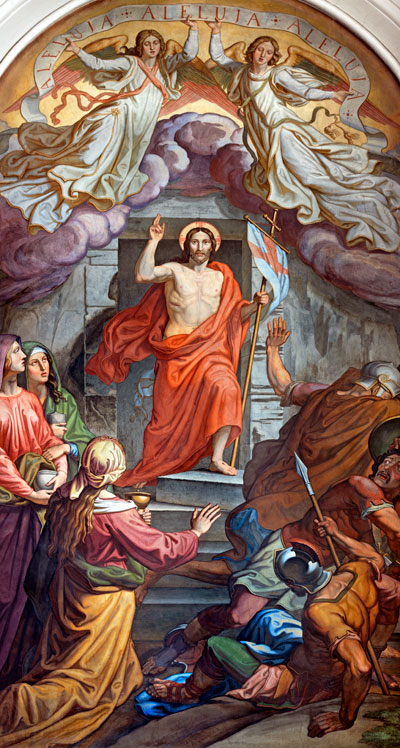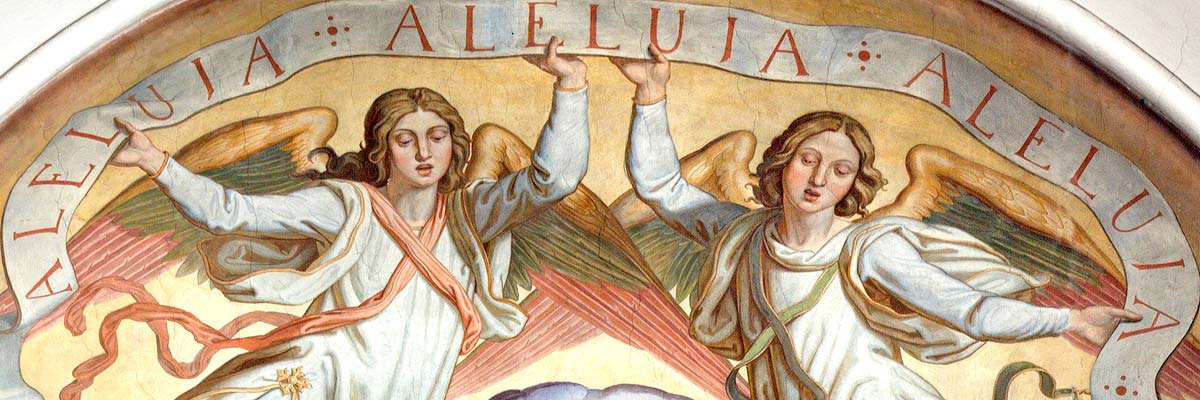Official Website of the
Catholic Diocese of Little Rock
Easter: All faith flows from the Resurrection
Published: April 20, 2025
Holy Week Schedule in Arkansas
Come. All are invited to celebrate this "Great Sunday;" the "Feast of Feasts:" Jesus' resurrection from the dead. To find an Easter Sunday Mass time in your area, click on the link above. Special Easter egg hunts are also planned. Confirm the schedule with the parish you wish to attend for any last-minute changes. If not listed, please visit our Parish Directory to find contact information for a parish near you."We know that Christ, raised from the dead, dies no more; death no longer has power over him. As to his death, he died to sin once and for all; as to his life, he lives for God. Consequently, you too must think of yourselves as being dead to sin and living for God in Christ Jesus." — Romans 6:9-11
St. Athanasius called Easter "the Great Sunday." The Catechism of the Catholic Church calls it the "Feast of feasts" and the "Solemnity of solemnities." Easter is the celebration of the Jesus' resurrection from the dead. This moveable feast falls on the Sunday following the first full moon after the vernal equinox. Visit our Parish Directory to find an Easter Sunday Mass in your area.
By taking on our sin, Jesus, through his passion, death and resurrection destroyed the power of sin and death and made it possible for us to have eternal life. That is the Good News. All faith flows from faith in the resurrection. "If Christ has not been raised, then empty is our preaching; empty, too, is your faith." (1 Corinthians 15:14)
 "The Resurrection of Jesus is the be-all and end-all of the Christian faith. If Jesus didn’t rise from the dead, all bishops, priests and ministers should go home and get honest jobs, and all the faithful should leave their churches immediately, because Christianity is a fraud and a joke. As Paul himself put it: 'If Christ has not been raised, then our proclamation has been in vain,'" said Bishop Robert Barron in his "Did Jesus Really Rise from the Dead?"
"The Resurrection of Jesus is the be-all and end-all of the Christian faith. If Jesus didn’t rise from the dead, all bishops, priests and ministers should go home and get honest jobs, and all the faithful should leave their churches immediately, because Christianity is a fraud and a joke. As Paul himself put it: 'If Christ has not been raised, then our proclamation has been in vain,'" said Bishop Robert Barron in his "Did Jesus Really Rise from the Dead?"
This e-book based on a podcast of the same name tackles some of the most often asked questions about the events surrounding Jesus' passion death and resurrection as well as arguments from skeptics to suggest it didn't happen.
In his Easter homily, Bishop Anthony B. Taylor took a similar approach. He addressed two popular theories used by non-believers. He also pointed out the problem with the scientific method of proof through only what is empirically observable.
"Science purposely ignores what it cannot see and so science cannot prove or disprove Jesus' resurrection," Bishop Taylor said. "Note, by the way, that the empirical method itself cannot be proven by the empirical method, which ought to give pause to those who reject good religion because they think all religion is incompatible with science, when it’s not."
"No one saw Jesus' resurrection, nor can it be repeated in scientific experiments. It's not that faith and science are in conflict because that’s not necessarily so. Jesus' resurrection simply belongs to the hidden 90 percent of reality that the empirical method is not equipped to investigate."
The significance of the resurrection is so important that the Church gives us 50 days to celebrate and reflect on it each year. The Easter Season continues through Pentecost.
The Catechism of the Catholic Church elaborates on why this event matters so much. "The Resurrection above all constitutes the confirmation of all Christ's works and teachings. All truths, even those most inaccessible to human reason, find their justification if Christ by his resurrection has given the definitive proof of his divine authority, which he had promised." (no. 651)
The word "Easter" comes from Old English, meaning the "East." The sun, which rises in the East, is a symbol for Christians of the rising Christ, who is the true Light of the world. The Paschal Candle is a key symbol of this divine light, which is Christ. It is kept near the ambo throughout the Easter Season and lit for all liturgical celebrations.
So what does the Easter Bunny have to do with Easter? Folklore suggests the custom came from Germany in the 1500s. Rabbits were considered the most fertile animals and were symbols of abundant new life in spring. The Easter Bunny was said to lay red eggs on Maundy Thursday and additional colored eggs the night before Easter. Learn more from Catholic Culture.
Our Sunday Visitor also explains that decorating eggs was a pagan symbol of rebirth at springtime for many cultures. Christians adopted the colored egg as a symbol of new life to represent the resurrection. The tradition of decorating with Easter lilies came into practice in the 1800s. This white flower, a symbol of purity and new life, also became a symbol of the resurrection.




